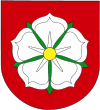 Alternate names: Zagórów [Pol], Zagrova, זאגורוב [Yid], Zaguruv, Загурув [Rus]. 52°10' N, 17°54' E, 30 miles NNW of Kalisz, 16 miles WSW of Konin, 8 miles S of Słupca. 1900 Jewish population: 658. Yizkor: Pinkas ha-kehilot; entsiklopediya shel ha-yishuvim le-min hivasdam ve-ad le-aher shoat milhemet ha-olam ha-sheniya: Poland vol. 1: The communities of Lodz and its region (Jerusalem, 1976). Gmina Zagórów is an urban-rural administrative district in Słupca County, Greater Poland Voivodeship, in west-central Poland with its seat is the town of Zagórów, 16 km (10 mi) S of Słupca and 72 km (45 mi) E of the regional capital Poznań. The gmina 2006 total population is 9,073 (population of Zagórów at 2,932). [July 2009]
Alternate names: Zagórów [Pol], Zagrova, זאגורוב [Yid], Zaguruv, Загурув [Rus]. 52°10' N, 17°54' E, 30 miles NNW of Kalisz, 16 miles WSW of Konin, 8 miles S of Słupca. 1900 Jewish population: 658. Yizkor: Pinkas ha-kehilot; entsiklopediya shel ha-yishuvim le-min hivasdam ve-ad le-aher shoat milhemet ha-olam ha-sheniya: Poland vol. 1: The communities of Lodz and its region (Jerusalem, 1976). Gmina Zagórów is an urban-rural administrative district in Słupca County, Greater Poland Voivodeship, in west-central Poland with its seat is the town of Zagórów, 16 km (10 mi) S of Słupca and 72 km (45 mi) E of the regional capital Poznań. The gmina 2006 total population is 9,073 (population of Zagórów at 2,932). [July 2009]
US Commission No. POCE000714
The town is located in Konin Voivodship at 52º10' 17º54', 15 km from Stuca and 30 km from Konin. Cemetery is located at Imielno (Kosciolkow). Present town population is 1,000-5,000 with no Jews.
- Local: Mayor Zdzislaw Rybicki, Zagorow, ul. Koscielna 4.
- Regional: Irena Sobierajska, PSOZ, Konin.
- Interested: Mr. Bogdan Grzonkowski (history teacher) Zagorow, ul. Koninska 66, Szkola Podstawowa (elementary school) Zagorow, Plac Szkolny 1, tel. #75.
Lucja Pawlicka-Nowak, 62-510 Konin, ul. 11 Listopada 51/76, tel. #434356 completed survey on September 10, 1992. Documentation: interviews and documentation of WKZ (conservator of monuments of the voivodship.) He visited site on August 27 and Sept. 10 1992 and interviewed Ms. Jadwiga Mikolajczyk (b. 1920) living near the cemetery: Zagoro (Kirchol) ul. Gajowa 4 on Aug. 27, 1992.
